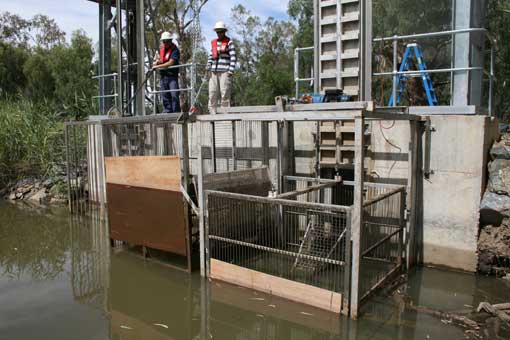For managers of water resources or infrastructure
NSW Department of Primary Industries (NSW DPI) regularly receives enquiries from Councils, water authorities, managers of sewage treatment works and others about how to manage carp infested areas of water they manage.
Depending on the situation the options may include:
- Commercial harvesting – under contract
- A carp separation cage – where there is an inlet/outlet through which carp pass
Commercial harvesting
The Inland Restricted Fishery (IRF) is the only commercial fishery in NSW authorised to harvest carp from inland waters (waters not subject to tidal influence) for sale. It is a small-scale fishery, with a limited number of fishers currently holding endorsements.
IRF endorsement holders may use commercial fishing gear to remove carp, subject to the conditions on their endorsement.
As with any other method of carp control, commercial harvesting may only remove a proportion of the carp present in an area, hence, sustained effort over a period of time may be required to substantially reduce the carp population in that area.
Public authorities or private businesses may engage an IRF endorsed commercial fisher to remove carp from a water body which they manage. Any such arrangement must be made directly between the authority/business and the commercial fisher.
If interested, authorities/businesses should contact the Commercial Fisheries Manager - IRF on (02) 6691 9624 for more information or to have their details forwarded to fishers for consideration.
Carp separation cages
 Carp separation cages are designed to trap carp for removal while allowing passage of native fish. They are significant pieces of infrastructure which can only be installed on an existing structure (eg. fishway / regulator).
Carp separation cages are designed to trap carp for removal while allowing passage of native fish. They are significant pieces of infrastructure which can only be installed on an existing structure (eg. fishway / regulator).
Ongoing operation and maintenance
In addition to the upfront capital costs for construction and installation, carp separation cages require a major ongoing operating/maintenance program.
Therefore, carp separation cages should only be installed where reliable ongoing arrangements can be made with the owner of the structure (eg. not relying exclusively on volunteer labour) to maintain and operate the device.
There should be a site-specific operational plan detailing the frequency with which the cage will be checked and carp removed, and how carp will be disposed of.
Periodic release of native fish should be automated and should occur at least daily.
Frequency of carp removal may vary by season or other factors affecting the biomass of migrating carp, but should be sufficient to ensure carp are not left in the trap for excessive periods and that the capacity of the trap is not overloaded during peak migration periods.
Note that carp separation cages have not yet been trialled in any coastal rivers and their use in any such location would require further research and development (eg. to avoid bycatch of mullet/eels).